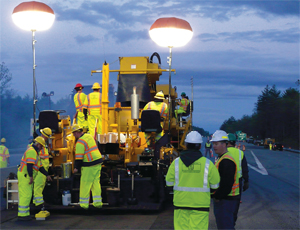Labor Day will be a mixed blessing in U.S. construction this year. Many workers will enjoy the day off, with employment secured by the American Recovery and Reinvestment Act. But others will see the holiday as a reminder of a frustrating job search and economic worry in a battered industry market that billions in federal stimulus may not be able to save.
President Barack Obama’s massive $787-billion stimulus package set an ambitious goal when enacted earlier this year: to jumpstart the ailing economy by creating and saving up to 3 million U.S. jobs. Construction’s share of ARRA funds, about $130 billion, has been slowly making its way into the marketplace, still beset by unclear rules of engagement, huge compliance requirements and overwhelmed contracting processes. One contractor jokes that he is “creating payroll” by having to hire staffers to meet new ARRA reporting requirements
Observers say that while the stimulus has helped stem the tide of job loss, it is far less than what was anticipated and has yet to reach the broadest array of industry participants. “It is crucial that the stimulus money quickly finds its way into the industry or thousands more construction workers will lose their jobs,” says Stephen Sandherr, CEO of the Associated General Contractors. But he and others also lament that ARRA has hyper-inflated bid lists, influenced municipalities to delay funding for larger and longer-term projects and distracted lawmakers from work on higher-impact job-growth catalysts such as federal highway spending reauthorization and banking reform.
“In an uncertain economy with a weak state-budget situation and a mounting federal deficit, construction industry executives are not flush with confidence that rehiring on a grand scale is, at least for the time being, a prudent move,” says Stephen M. Hughes, construction, engineering and infrastructure practice leader and a managing director of investment banking at Columbus, Ohio-based KeyBanc Capital Markets.
Market conditions, now and predicted, generated a glum third-quarter industry report from analyst FMI Corp., Raleigh, N.C. “The hope for a quick recovery has faded, and contractors are now slugging it out in the trenches trying to keep backlogs full [while] facing increasing competition,” it says. “ARRA has led to a certain amount of frustration in responses this quarter.” But Robert A. Murray, vice president of economic affairs for McGraw-Hill Construction, ENR’s parent, cautions, “It is still too early to cast aspersions [on the stimulus]. “We will see growing economic momentum by the end of the year and in early 2010, when some economists predict rising unemployment.”
ARRA’s positive results are beginning to trickle in, according to the Economic Policy Institute, a Washington, D.C., research group. Because gross domestic product growth in the second quarter of 2009 would have lost 2% to 3% without the stimulus, nearly 500,000 to 750,000 jobs were saved, says EPI.
With “shovel ready” as the ARRA mantra, transportation work has been a key funding target and economic-stimulus beneficiary, particularly paving and other work that has fewer environmental rules. The American Road and Transportation Builders Association says that, as of Aug. 18, $18 billion of ARRA funds were obligated for such projects, 66.8% of the $26.9 billon of the total apportioned to date.
| State | Total Jobs* | ||
|---|---|---|---|
| Washington | 3,481 | ||
| Oregon | 3,188 | ||
| Pennsylvania | 2,744 | ||
| Indiana | 2,565 | ||
| Illinois | 2,315 | ||
| Utah | 2,288 | ||
| Oklahoma | 2,198 | ||
| Minnesota | 2,143 | ||
| Texas | 2,056 | ||
| Iowa | 1,795 | ||
| North Carolina | 1,786 | ||
| Arkansas | 1,636 | ||
| Wisconsin | 1,624 | ||
| Missouri | 1,490 | ||
| South Dakota | 1,427 | ||
| California | 1,376 | ||
| Mississippi | 1,270 | ||
| Maine | 1,242 | ||
| New Jersey | 1,171 | ||
| New York | 981 | ||
|
*Number of direct, on-project jobs created or sustained with American Recovery and Reinvestment Act funds through June 30, 2009. Projects are in categories of highway infrastructure, transit capital assistance, fixed guideway and clean- water state revolving funds. Not all categories were reported by states. Source: House Transportation and Infrastructure | |||
The House Transportation and Infrastructure Committee tabulated that, as of July 30, more than close to 77,500 “direct” jobs were saved or created in the transportation and environmental infrastructure sectors. “Tens of thousands” more positions in supporting industries such as equipment and materials manufacturing, also were generated, the committee says. But quantifying actual jobs created or saved can be difficult, with few hard numbers showing a definite total. “Some jobs will have someone [working] in three different locations—how do you count that person?” says Tony Dorsey, spokesman for the American Association of State Highway and Transportation.
Anecdotally, firms report the stimulus is doing what Congress intended. Christian Zimmermann, president of Pike Industries Inc., a Belmont, N.H., paving contractor, says ARRA-funded work will have saved or created 250 jobs in his firm this year. He credits the forethought of contractors and state highway officials in New England in preparing last year for an anticipated stimulus, streamling approvals and halving contract award times. “A job was bid on Thursday, and we would have the contract in hand the next week,” says Zimmermann, allowing the firm to save jobs it might otherwise have had to cut.
New Hampshire, a key market for Pike, is the country’s second-best ARRA implementer among states, with 64% of funded projects under way as of June 30. Transportation departments in five southern states announced on Sept. 1 that they had a total stimulus payroll of $13.4 million as of July. But in Aug. 6 letters, House Transportation and...















Post a comment to this article
Report Abusive Comment